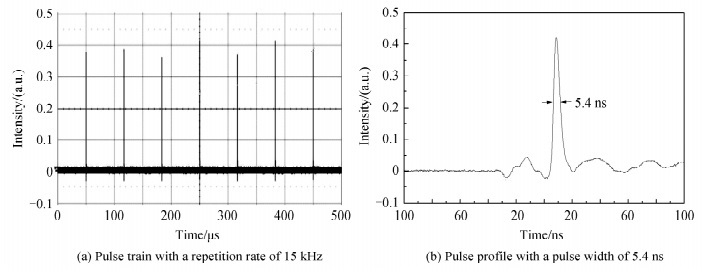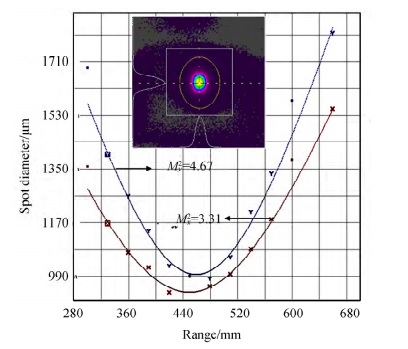Q-switched laser
The pulse behavior of the Q-switched laser was measured by a photodiode connected to an oscilloscope. No multiple-pulse is formed at various pump powers and repetition rates. The pulse train obtained at a repetition rate of 15 kHz is shown in figure (a) below. It is clear that both the pulse strength and pulse interval are stable, the instability of pulse strength is approximately 6.8%. It demonstrates that the Q-switching performance was not influenced by the piezoelectric ringing effect. The pulse widths at various repetition rates are plotted versus the pump power in figure (d) above. The dependence of the pulse width on the pump power is not obvious, which may be explained by the following reasons. On the one hand, the decrease in the number of round trips may not be significant due to the small increase in the pump power. On the other hand, the round-trip time is small due to the short cavity length, even if the number of round trips is decreased slightly, the variation in the pulse width is not obvious. The shortest pulse width at the repetition rate of 15 kHz is 5.4 ns with a pump power of 1.41 W, the pulse profile is shown in figure (b) below. The maximum peak power is calculated to be 2.94 kW for a repetition rate of 15 kHz.
Pulse behavior of the Q-switched laser
The typical beam profile of the Q-switched laser at a repetition rate of 15 kHz with a pump power of 1.41 W was measured with a laser beam analyzer. The distributions of the laser intensity and the measured beam diameter at different distance from a lens (f=250 mm) are shown in figure below. Note that the images captured by the CCD were rotated by 90° relative to the original beam. By fitting Gaussian beam standard expression to these data, the beam-quality factors were estimated to be Mx2 = 3.31 and My2 = 4.67. The waist radiuses of the Q-switched laser were estimated to be ωx = 0.362 mm and ωy = 0.406 mm. The non-circular symmetry of the laser beam is thought to be caused by that one side of the Nd:YVO4 crystal was Brewster-cut. Additionally, by employing a rotating quarter-wave plate method, the polarization degree of the laser was estimated to be 0.9721. At these conditions, there was no damage observed in any component of the laser cavity. Thus, the miniature LN Pockels cell (www.wisoptic.com) can be expected to operate in lasers with higher peak power and higher repetition rate.
Beam quality for 15 kHz Q-switched laser at a pump power of 1.41 W
Conclusion
We have investigated the piezoelectric ringing effects in LN PCs with different dimensions and in a RTP Pockels cell (www.wisoptic.com). The results demonstrate that the piezoelectric ringing effects in LN PC is influenced by the applied voltage and the piezoelectric resonance frequency of PCs. The piezoelectric ringing effect in the miniature LN PC are negligible owing to its lower switching voltage and larger piezoelectric resonance frequency. With the miniature LN crystal as the EO Q-switch, we have successfully demonstrated a high repetition rate Q-switched Nd:YVO4 laser. At pump power of 1.41 W, a stable pulsed laser operating at a repetition rate of 15 kHz with a pulse width of 5.4 ns and a peak power of 2.94 kW was obtained.
Post time: Jun-30-2022


